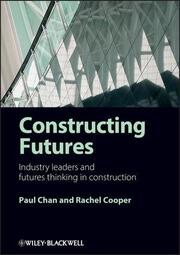Detailansicht
Constructing Futures
Industry leaders and futures thinking in construction
ISBN/EAN: 9781405157971
Umbreit-Nr.: 1322859
Sprache:
Englisch
Umfang: 240 S.
Format in cm:
Einband:
gebundenes Buch
Erschienen am 26.11.2010
Auflage: 1/2010
- Zusatztext
- InhaltsangabeAbout the authors. Preface. Part 1 Tracing the past. 1 Introducing foresight in construction: exploring the missing link of personalising futures thinking. Chapter summary. Setting the 'scene'. Construction foresight studies. The 'future' agendas since the Second World War. Contemporary foresight reports at the turn of the century. Synthesis of critical trends and implications from the foresight reports. Critical appraisal of foresight studies. A note on the methodology. The structure of the book. Part 1: Tracing the past. Part 2: Eliciting the future. Part 3: Towards an afterthought. 2 Influential people in the UK construction industry: what makes leadership in construction? Chapter summary. Introduction. Leadership theories and application in construction. Development of leadership theories. Application of leadership theories in construction management research. Looking forward but learning from the past. So what makes a 'leader' in construction? Critical antecedent: people. Critical antecedent: place. Critical antecedent: events. To be or not to be? The age-old question of nature and nurture. Closing thoughts. Part 2 Eliciting the future. 3 Developing a sustainable future: theoretical and practical insights into sustainable development. Chapter summary. Introduction. Connecting people, profits and planet: the rise of the sustainability agenda. Interactions between people and places. Role of political leaders and infrastructure development. Industry response to the sustainable development agenda. Role of education and research. Summing up the thoughts of our leading figures. Sustainability: definitions and perspectives. Manmade capital: problems with an outputdriven model. Human capital: the rhetoric versus reality of investing in people. Natural capital: consensus gained or paradise lost. Social capital: building trust and sustainable communities. The measurement problem: are efforts towards sustainable development doomed to fail? Closing thoughts. 4 Connecting up government, corporate and community stakeholders in governing the future of the construction industry. Chapter summary. Introduction. Governance of the industry: seeking an institutionally coordinated response to meet the challenges of the future. Think global act local. The changing role of government: relinquishing control to the private sector. Publicprivate interface. People and managing relationships in construction. Bringing interactions to the fore: exploring the intersections between government, corporate and community actors. Shifting perspectives of governance. Political governance: governance without government. Corporate governance: the rise of corporate social responsibility. Community governance: revisiting social capital. The need for joined-up governance. Governance in construction: the trends of privatisation and community engagement. The relationship between government and construction. Structure of the industry. Changing landscape of professionalism. Connecting political, corporate and community governance in construction: the importance of human relations. Closing thoughts. Part 3 Towards an afterthought. 5 The last word: synthesising lessons learnt from the journeys. Chapter summary. Introduction. Recap on previous chapters. Leadership as an emergent process: moving away from individualistic notions of leadership in construction. The missing social link of sustainable development. The aspirations of joined-up governance. Key conclusions. Futures thinking as emergent thinking. Disrupting boundaries: the age of hybrids. Tensions, ambiguities and paradoxes. Knowledge gaps to frame the research and practice agenda of the future. Epilogue. Appendix: Brief biographies of influential figures interviewed.
- Kurztext
- The growing interest within the construction industry in future scenario planning has not always corresponded with an understanding of how futures thinking is shaped in policy-making. Constructing Futures: industry leaders and futures thinking in construction takes a thematic approach to the future of the UK construction industry. It presents the results of a series of in-depth interviews conducted with leading construction figures and then structures the discussion into chapters addressing key contemporary issues in the industry. These highprofile figures are drawn from a wide range of stakeholder groups representing the realities of construction including architects, client organisations, consultants, contractors, developers, lobby groups with special interests, policy makers, professional institutions, and trade unions. A total of 15 influential figures were interviewed for the book, from Sir Michael Latham and Bob White to Wayne Hemmingway and Kevin McCloud. The authors juxtapose the interviewees' views with their own examination of both mainstream and construction management literature on current issues affecting the industry, combining practical insights with an exploration of the key theoretical debates. Part I of the book looks at the industry's past, reviewing a series of foresight studies of the construction sector and re-presenting stories of the interviewees' lives to examine the development of leadership in the industry. In Part II, the authors focus on two fundamental issues in today's construction industry: sustainable development and governance. Part III looks to the future, highlighting key lessons learnt and proposing a series of research questions for industry and academia.
- Autorenportrait
- Paul Chan, Lecturer, School of Mechanical, Aerospace and Civil Engineering, University of Manchester, UK. Rachel Cooper, Lancaster Institute for the Contemporary Arts, University of Lancaster, UK.
